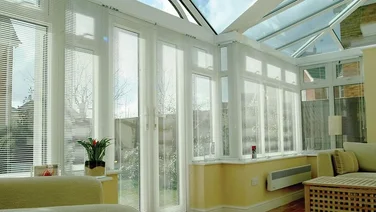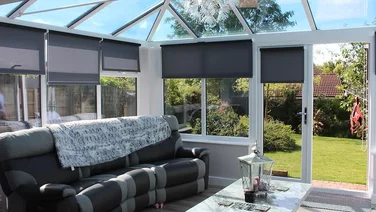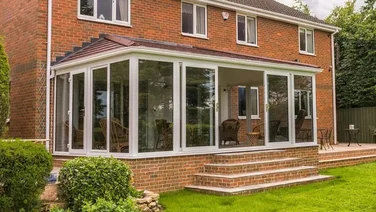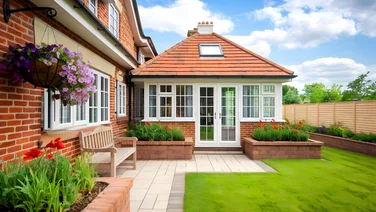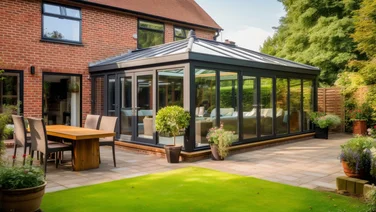- Replacing a conservatory roof typically costs between £2,300 and £6,000
- The most popular materials are glass, polycarbonate, and tiles
- Use the form above to get free quotes for a conservatory roof
A conservatory can be a great addition to your property, but they are expensive. It’s important to know how much a conservatory costs and what you will be spending on before you get started.
One of the biggest expenses is the material to the roof as this can affect the durability, and your enjoyment, of your conservatory.
We’ve put together this guide to help you understand what you need when looking for the right material for your conservatory roof.
If you want to skip ahead and connect with suppliers, fill in this form and get started.
How much does it cost to replace your conservatory roof?

The average cost of a conservatory roof replacement can range widely, depending on several factors. There are a lot of things to consider, such as the size of your conservatory, the roof material, and installation time.
As an estimate, a new conservatory roof will typically cost between £2,300 and £6,000. We understand this isn’t terribly specific, so feel free to take a look at our detailed page on conservatory roof replacement costs for more information.
A polycarbonate conservatory roof is the cheapest to replace, and will usually cost between £2,500 and £5,500. Glass and solid conservatory roofs cost more to replace, and you should expect to pay anywhere between £3,000 and £7,000.
To get a more accurate idea of how much your conservatory roof replacement is going to cost, fill in this form and our suppliers will get back to you with their best prices.
Do I need to change my conservatory roof?
If your conservatory experiences any of these problems, it’s time you got an upgrade:
• Oppressive heat in the summer
• Arctic conditions in the winter
• Loud rain on the roof
• Leaking, mould and/or condensation
• ‘Unpleasant roof’ vibes
How long does a conservatory roof last?
How long your conservatory roof will last depends on what material it’s made from. A glass or polycarbonate conservatory roof will last about 10 to 15 years, whereas you can expect a conservatory with a solid roof to last much longer – around 50 years (or more). Slate and clay roof tiles can have up to double the lifespan of cement roof tiles.
What are the best conservatory roof materials?
There are three materials to choose between for your conservatory roof: glass, polycarbonate, and tiles. Your choice depends largely on your budget, and what you’d like to use your conservatory for.
‘No roof’ is an affordable fourth option if you want your conservatory to recreate the great outdoors, but it won’t make the room very useable.
Here’s what you need to know about each material.
Glass conservatory roofs
If you want to fill your conservatory with natural light, look no further than the king of transparency: glass.
As long as you keep it clean, glass will happily let any daylight pass right on through, brightening up your conservatory and making the space feel a whole lot bigger. Plus, any plants in a glass conservatory are bound to fare much better than their green brothers and sisters suffering under a tiled or polycarbonate roof.
Double glazing has turned glass into a powerhouse of thermal efficiency, meaning glass conservatories are no longer just expensive greenhouses.
A glass roof won’t leak out all of your house’s internal heat, which means you’ll save on energy bills. A double-glazed glass roof will last at least 15 or 20 years.
Modern technology has also given us some pretty fancy glass varieties, such as ‘self-cleaning glass’ (which reacts with the sunlight to break down dirt) and ‘tinted glass’ (which protects against UV rays and preserves your furniture).
Finally, glass always looks the part, so you can really impress visitors with your conservatory. “Wow, what a classy conservatory!”, they’ll say. If that’s not enough, you can also use aluminium frames to add to the sleekness.
On the down side, glass isn’t the cheapest option, generally costing more than polycarbonate (but less than tiles).
Polycarbonate conservatory roofs
Polycarbonate is the most affordable material, made from multiple layers of plastic sheeting with an air gap in the middle.
While its appearance is much less sophisticated than glass, polycarbonate still lets in a great deal of natural light. You’ll barely have to do anything in the way of maintenance, and most polycarbonate roofs last at least 15 or 20 years.
However, polycarbonate is the cheapest choice for a reason, and it comes with a fistful of cons. Most significantly, its thermal efficiency is pretty poor, so you’ll end up with a hot room in summer and a chilly one in winter.
On top of this, rainfall can often make quite a big racket when it lands on polycarbonate, so you won’t be having any rainy-day naps in there.
Solid or tiled conservatory roofs
A tiled roof will give you less daylight than glass or polycarbonate, but it will transform your conservatory into a proper extension of your home. Its thermal efficiency is in a totally different league, so you can use it all year round without worrying about the temperature.
The improved insulation and reduced glare will give your conservatory a whole new purpose (such as a home office or a guest bedroom), rather than just ‘the place you have tea when your gran comes round’.
You can learn more about this on our Complete Guide to Conservatory Insulation.
If want the best of both worlds (i.e. lots of natural light and amazing insulation) then you can add Velux-style windows to your tiled roof. To find out more, check out our page on roof window costs.
Tiled roofs are tough and independent, which means that upkeep is low and that they’ll typically last at least 50 years. What’s more, they’re very versatile, so you can choose the perfect tile colour to match the rest of your house. Tiles don’t possess that glassy sheen and sparkle, but they’ll still give your conservatory a seriously sophisticated look.
The installation of a tiled roof can often require a lot more work than glass or polycarbonate, but all good things take time. Conservatories were not built to withstand the weight of a heavy roof, so additional supports (such as rafters and batons) will need to be installed.
For more information about tiled roofs (including typical costs), head to our page about solid conservatory roofing.
Is a glass roof better than polycarbonate?
Yes. Although a glass conservatory roof can be up to 4 times more expensive than a polycarbonate roof, a glass conservatory roof offers many more benefits.
Glass is a much better insulator than polycarbonate, meaning your conservatory will stay warmer during the colder months.
This can save you money on your energy bills as you’ll rely less on your central heating. Glass also lets in much more natural light than polycarbonate conservatory roofs.
Polycarbonate tends to be made of a slightly opaque plastic, meaning you won’t be able to see outside clearly.
Do I need planning permission to put a solid roof on a conservatory?
In the days of old (before 2010), you would have needed planning permission, but everything has changed. You already got planning permission for the conservatory itself (we hope), so you don’t need it again for a replacement roof.
However, you do need Building Regulatory Approval, which is concerned with people’s homes being built according to certain safety standards. This is because a solid roof will change the classification of your conservatory from a ‘temporary structure’ to a ‘permanent’ one.
An official from your local Building Control department will have to carry out a survey on your existing conservatory, deciding whether the windows and doors need to be replaced. Your conservatory’s bearing load must be strong enough, otherwise you’ll be creating a top-heavy death trap.
You can get more details from the Local Authority Building Control.
Who are the best conservatory roofing companies?
When choosing your conservatory roofing company, we recommend that you make sure they’re a member of The Conservatory Association. This is made up of 230 UK-based manufacturers who care an awful lot about top quality conservatories, so you can be sure their services will be top notch.
Summary
- The cost of a conservatory roof depends on a lot of factors, including size, materials and installation time
- Cost estimates are between £2,300 and £6,000
- A glass or polycarbonate conservatory roof will last between 10-15 years
- Since 2010, it hasn’t been necessary to get planning permission to put a solid roof on a conservatory
- To receive quotes from professional installers, fill in your details, and our suppliers will get back to you.


